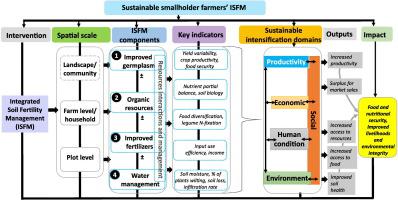Agricultural Systems ( IF 6.6 ) Pub Date : 2022-09-18 , DOI: 10.1016/j.agsy.2022.103496 Job Kihara , Julius Manda , Anthony Kimaro , Elirehema Swai , Christopher Mutungi , Michael Kinyua , Patrick Okori , Gundula Fischer , Fred Kizito , Mateete Bekunda

|
CONTEXT
The implementation of integrated soil fertility management (ISFM) varies widely among farmers, from no ISFM to multiple computations of ISFM components (i.e., improved germplasm, organic resources, fertilizers, and local adaptations e.g., soil and water conservation (SWC)). There is no comprehensive report on farmers' use of ISFM components and their impact on sustainable intensification domains of productivity, economic, social, human condition, and environment and the associated variations across farmer fields and agro-ecological zones (AEZs).
OBJECTIVE
This study 1) evaluated the current implementation status of ISFM by farmers in relation to the various ISFM components and 2) provided multi-dimensional multi-scale evidence of ISFM implications that can guide ISFM investments within SSA contexts, with a specific focus on Tanzania.
METHODS
We used data collected from 1406 plots between 2013 and 2020 in semi-arid and sub-humid AEZs. The data are from farmer practices. The plots were grouped by the various combinations of ISFM components implemented and analysed using Tukey's test to examine the association of ISFM use with selected indicators within a domain.
RESULTS AND CONCLUSIONS
The number of ISFM components used by farmers is higher in sub-humid (1 to 4) than in semi-arid AEZ (0 to 3). Except for SWC used by 40% of farmers in both AEZs, the proportion of farmers using improved seeds (95%) and manure (55%) in the sub-humid AEZ are more than double those using these ISFM components in the semi-arid AEZ. Productivity and economic benefits increase with the number of ISFM components at the expense of higher labour demand. Increasing plot-level ISFM benefits also translate to increased household-level whole-farm income but contributions to human nutrition are unclear. The contribution to SOC by increasing ISFM is insignificant, compounded by strong effects of slope position of the field. Differential access to resources, decision-making and control rights drive the number and choice of the specific ISFM components.
SIGNIFICANCE
Understanding of ISFM impacts across domains is essential to guide the scaling of ISFM in Tanzania and beyond and therefore recommended in future studies.
中文翻译:

综合土壤肥力管理 (ISFM) 对坦桑尼亚各种可持续集约化影响领域的贡献
语境
综合土壤肥力管理 (ISFM) 的实施在农民之间差异很大,从没有 ISFM 到对 ISFM 组成部分(即改良种质、有机资源、肥料和当地适应性,例如水土保持 (SWC))进行多次计算。没有关于农民使用 ISFM 组件及其对生产力、经济、社会、人类条件和环境的可持续集约化领域的影响以及农民田地和农业生态区 (AEZ) 的相关变化的综合报告。
客观的
本研究 1) 评估了农民对 ISFM 各个组成部分的当前实施状况,2) 提供了 ISFM 影响的多维多尺度证据,可以指导 SSA 环境中的 ISFM 投资,特别关注坦桑尼亚。
方法
我们使用了 2013 年至 2020 年间在半干旱和半湿润 AEZ 的 1406 个地块收集的数据。数据来自农民实践。这些图按 ISFM 组件的各种组合进行分组,并使用 Tukey 测试进行分析,以检查 ISFM 使用与域内选定指标的关联。
结果和结论
农民使用的 ISFM 成分数量在半湿润(1 到 4)高于半干旱 AEZ(0 到 3)。除了两个 AEZ 中 40% 的农民使用 SWC,在半湿润 AEZ 使用改良种子(95%)和粪肥(55%)的农民比例是半干旱 AEZ 使用这些 ISFM 成分的农民的两倍以上AEZ。生产力和经济效益随着 ISFM 组件数量的增加而增加,但以更高的劳动力需求为代价。增加地块层面的 ISFM 收益也转化为增加家庭层面的全农场收入,但对人类营养的贡献尚不清楚。增加 ISFM 对 SOC 的贡献是微不足道的,再加上场坡位置的强烈影响。对资源的不同访问权、决策权和控制权推动了特定 ISFM 组件的数量和选择。
意义
了解跨领域的 ISFM 影响对于指导 ISFM 在坦桑尼亚及其他地区的扩展至关重要,因此建议在未来的研究中使用。



























 京公网安备 11010802027423号
京公网安备 11010802027423号